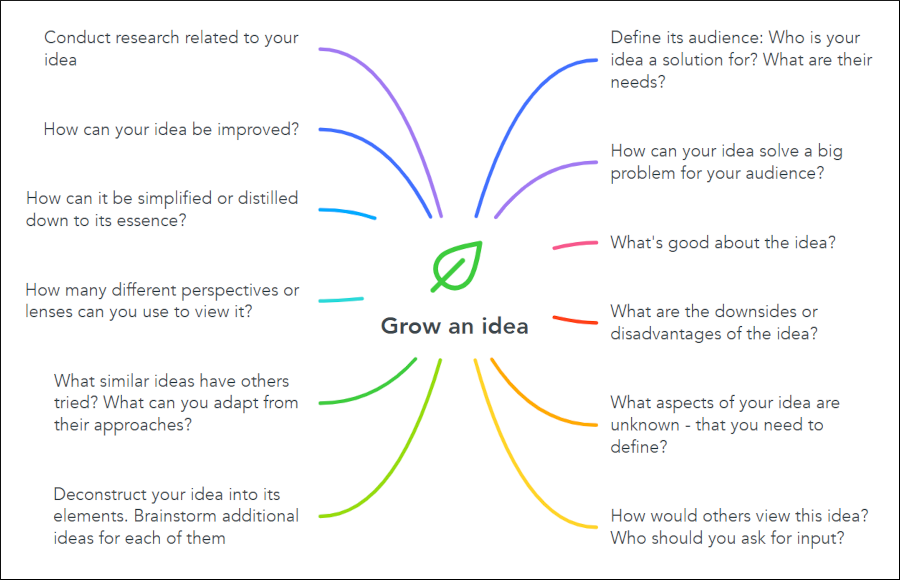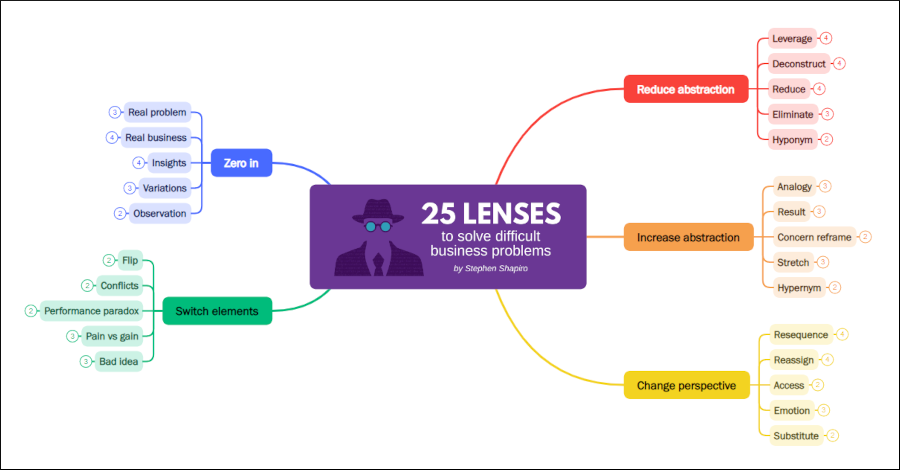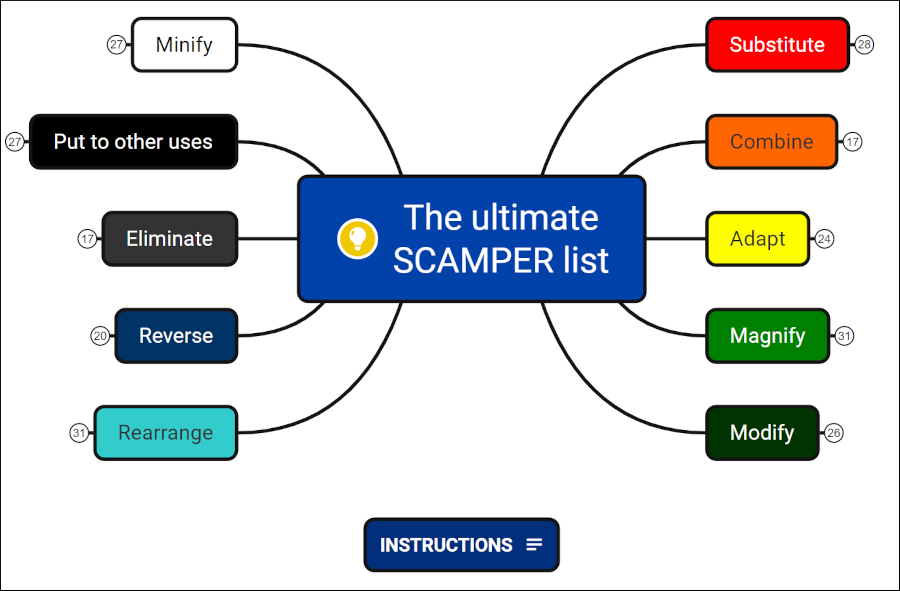
You’ve brainstormed a really promising idea. That’s awesome! Now what? How do you build upon it?
You’ve captured your really big idea in a digital note, but now it’s staring at you, daring you to add more detail to it. To figure out how to implement it. But your mind has gone blank.
You wonder: “What if there was a way for me to grow, improve and flesh out my Big Idea that would help draw my best thinking out of my mind?”
There is! Mind mapping tools leverage your brain’s immense power of association to draw forth your best thinking and capture it in an engaging, visual format that encourages your muse to keep going. When your subconscious mind sees an empty mind map branch, it automatically springs into action to fill it.
Here are 12 mind-expanding prompts you can use to develop your Really Big Idea:
1. Define its audience: Who is your idea a solution for? What are their needs?
Why should you define an audience for your writing? Can’t you just write for an audience of everyone? Not really. If you’re trying to write for everyone, chances are your message will be so general that it won’t resonate with anyone.
Selecting a target audience will help you to focus your message on their precise needs, increasing the odds that they will take the action you want them to. Be specific. What is the professional background of your ideal audience? How many years of experience do they have? What kind of education do they have? Capture all of this in a persona mind map . You can use this as a tool when writing to make sure that your words and the stories you’re telling are focused on their needs.
2. How can your idea solve a big problem for your audience?
Once you have created a profile of your ideal audience, turn your attention to the problems and challenges they tend to deal with. What worries them? What keeps them awake at night? Capture all of this information in your mind map.
Once you’ve done so, give some thought to which of those problems you can help them to solve. Your answers to this question will help you uncover potential topics you can write about. Describe these challenges and their potential solutions and as much detail as you can. Don’t worry about doing so neatly. You can always arrange and rearrange the topics of your mind map to create a cohesive picture.
3. What’s good about the idea?
After you have captured your idea and have had some time to think about it, it’s time to look at a critically. A great place to start is to ask yourself, what’s good about it? What excites you about the idea? What makes you think it may be potentially valuable for your target audience?
Capture as much detail as you’re able about your thoughts and feelings about it. Use as many levels of topics as you need to.
4. What are the downsides or disadvantages of the idea?
Now flip your perspective and consider its downsides. Why might this NOT be a good idea? What are its potential shortcomings? Why ight it be impractical? What might limit its value?
For best results, place the the advantages and disadvantages of your idea on adjacent mind map branches. That will enable you to see patterns in your thoughts and may help suggest new ones.
5. What aspects of your idea are unknown – that you need to define?
Many times, when you first come up with an idea, it’s like an amorphous blob. It’s hard to tell what shape it could take. For this step, let your gut feelings guide you. What isn’t known about your idea? What feels uncertain about it? Outline those factors in your mind map, and then brainstorm a list of the elements of your idea you need to define. Also outline your plan to gather that information.
6. How would others view this idea? Who should you ask for input?
Often, we’re too close to our ideas to evaluate them in an unbiased way. We may be “blind” to its full potential or its shortcomings. Often, when you share your idea with others, they can add exciting new value to it, making it bigger and more valuable than you could have ever envisioned. But it’s critical that you pick the right people to share it with. Positive, creative people are an obvious first step.
Avoid critics, who can easily send your big idea to an early grave.
Don’t overlook people who are close to you and whose opinions you trust. They probably don’t know anything about your profession or industry. But that’s actually a good thing. Why? Because they can provide you with honest opinions that aren’t colored by existing knowledge or perceptions. Often, it’s people like these who illuminate aspects of your idea or concerns that you may have never even considered.
7. Deconstruct your idea into its elements. Brainstorm additional ideas for each of them
One powerful way to improve an expand upon an idea is to disassemble it into its component parts. This exercise can reveal additional ideas and insights that weren’t visible at first. It can also be a powerful problem-solving technique.
In the same way that splitting an atom can release tremendous amounts of energy, splitting an idea can also release abundant creative energy.
8. What similar ideas have others tried? What can you adapt from their approaches?
There are very few totally new to the world ideas. Most have been built upon the shoulders of other innovations that have come before. One of the questions you should naturally ask when brainstorming your big idea is “is this idea unique?” Doing some research to see how others have solved similar problems in other industries or professions is a good way to discern this.
You may discover some elements of their solutions that you can adapt or add to your idea, making it unique for the audience you plan to serve and the problem you aim to solve.
9. How many different perspectives or lenses can you use to view it?
One of the things that makes us human is that we tend to view almost everything from a fairly limited perspective. Unless we are intentional about it, it’s hard to imagine seeing your idea from new perspectives. But doing so can help you become much more creative.
One excellent framework for doing this is Stephen Shapiro’s book, Invisible Solutions. It outlines 25 mental filters or “lenses” that can help us systematically frame our problems, challenges and opportunities and release our best thinking. Each of them contains questions that help to direct our thinking in new directions, so we can consider new opportunities and possibilities. Read more about Invisible Solutions and download a mind map of all of the lenses here.
10. How can it be simplified or distilled down to its essence?
What if you were to try to simplify your idea? Is there an underlying essence that you can distill and capture in your mind map? This may reveal itself when you deconstruct your idea as suggested in technique number 7.
11. How can your idea be improved?
This is one of the easiest ways to add value to your idea. Chances are, there are multiple ways to make your Big Idea even more valuable. One of the best ways to do that is using an idea improvement framework called SCAMPER. Its name is a mnemonic for Substitute, Combine, Adapt, Modify/Magnify/Minify, Put to other uses, Eliminate and Reverse/Rearrange. It forces you to look at challenges or problems from a variety of creative perspectives. In so doing, it whacks you out of your usual, rutted mode of thinking and often yields valuable, creative ideas. In short, it’s popular because it delivers results! Check out the Ultimate SCAMPER Map here.
12. Conduct research related to your idea
You’ve captured your idea and have used some of the techniques outlined in this article to add to it and improve it. But now you’ve hit a plateau. What next?
One fruitful way to regain your momentum is to do some research that’s focused your Big Idea. Here are some catalysts to get you going:
- Conduct a Google search on keywords related your Big Idea.
- Search for subject matter experts – people with whom you could talk to about your idea and get their perspectives on it – pros, cons, ways in which it can be improved and more.
- Give some thought to ideas and concepts that are ADJACENT to your idea. Conduct searches around them.
- Expand your search beyond Google. Conduct a search on Amazon.com for books that may be related to your topic or idea.
Conclusion
Generating a Big Idea is just the start of your creative journey. With the right tools and frameworks, you can easily grow a small idea into a big one that is significantly more valuable.
Download the idea growth mind map (Xmind format) here.





Leave a Reply